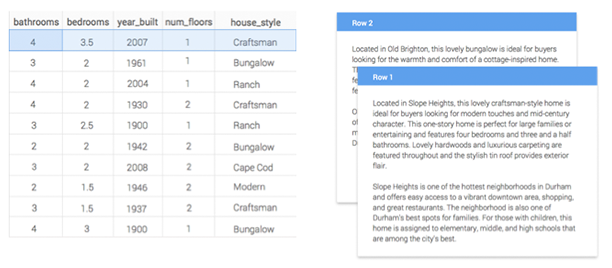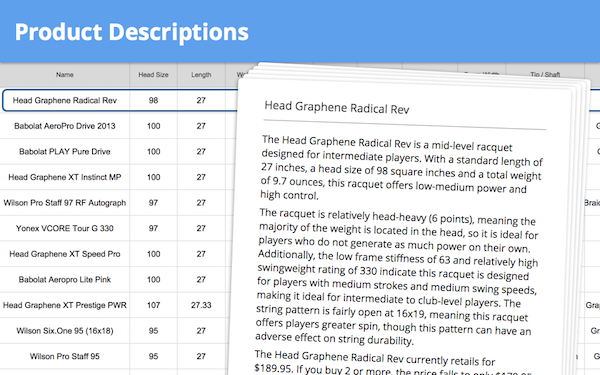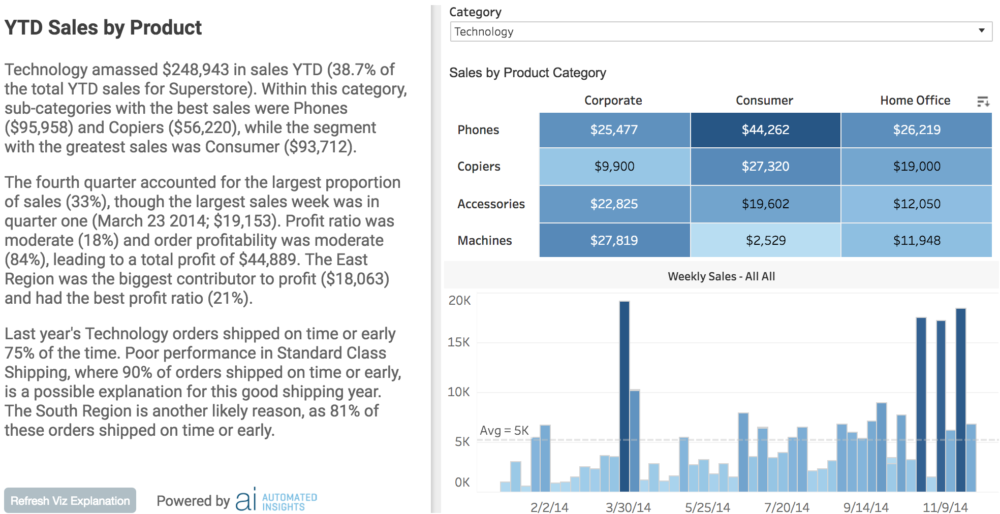Natural language generation (NLG) is a software process that automatically turns data into human-friendly prose.
The main requirement for implementing NLG is the ownership and access to a structured dataset. In order for any natural language generation software to produce human-ready prose, the format of the content must be outlined and then fed structured data.
For example, our Wordsmith platform accepts structured data via uploading a CSV directly, passing the data to our API as a JSON object, or through one of our integrations that connect to the API like Zapier or Tableau.

NLG enables creation of unique property listings for each row of data.
NLG software in its current state will not pull unstructured data and magically generate written text without human guidance.
NLG Use Cases
While NLG can be implemented wherever there is a need to generate content from data, some of the most common uses of the technology include:
- generating product descriptions from inventory data
- creating individual financial portfolio summaries and updates at scale
- business intelligence performance dashboard text explanations
- real estate property descriptions
- personalized customer communications
Every NLG narrative is designed to read as though a human wrote it. The specific data insights and writing style of each narrative vary widely depending on the specific case and audience. The structure and tone of each piece of content is determined by the person designing the narrative structure, or template.
This is why NLG is flexible enough to generate data-driven narratives about industries ranging from finance and business intelligence to e-commerce and sports.
Advantages of Using NLG
Save Time and Money
With NLG, you can produce thousands of unique narratives in the time it takes to write a single piece of content.
For example, the process of writing hundreds or thousands of product descriptions is time-consuming and costly-whether that’s stealing valuable time from in-house writers or hiring an army of freelancers to complete the task.

With NLG, each row in a structured dataset, like a CSV of inventory specs, can be transformed into a unique, variable description. This process can occur at scale, generating thousands of unique, variable descriptions for every item in an e-commerce store’s inventory.
Extensive Personalization at Scale
NLG enables you to generate complex personalization at scale, creating improved customer communication and experience with your organization.
A financial services firm, for example, can deliver individualized portfolio summaries to thousands of clients while reducing the cost of production.
Natural language generation works for companies with both a large established customer base and for companies expecting rapid growth of their client pool. That’s because NLG enables businesses to make full use of existing data while allowing for the addition of new client data to produce unique content for each individual customer, without an exponential increase in cost.
Check out our Orlando Magic case study on improved customer communications through personalization.
Make Data Understandable and Useful
Charts and graphs can be visually overwhelming and often require additional explanation from the experts manipulating the supporting data. Natural language conveys expert-level analysis and advice in concise, plain terms that engage and fully inform each reader.
For example, NLG enables every sales person on a large team to have a performance report tailored precisely to them, benchmarking their individual performance against their peers and giving suggestions for improvement.
NLG can also be integrated into existing business intelligence dashboards so that the generated text changes in tandem to different visualization filters.

Our Wordsmith platform, for example, is integrated with Tableau so that users can also generate custom, responsive narrative explanations of their data visualizations. The narrative can be customized to use a business’s unique terminology, as well as edited to highlight the most important metrics for each of the company’s departments.
Check out live, responsive examples of our Tableau integration.
The Future of NLG
In the past, natural language generation implementations would take months of work by professional data scientists and software developers. A business might invest thousands of dollars in NLG solutions without seeing any content for several quarters.
Today, our Wordsmith platform makes it easy for anyone to upload data and start automating their own consumer-facing stories in a few hours. Wordsmith users can also take advantage of many integrations to quickly implement NLG in their existing processes. And don’t be fooled by the nomenclature-“template” NLG is just as complex as “advanced” natural language generation. The content produced by both methods will be as intricate as the writer constructing the software logic makes it.


